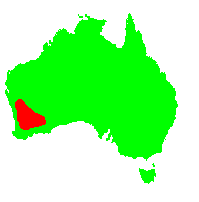General Description:
Kunzea is closely related to the genus Callistemon (the bottlebrushes) and also bears some similarity to Melaleuca and Leptospermum. There are about 40 species occurring in all states and territories. One species also occurs in New Zealand. They are small to medium woody shrubs and the majority occur naturally in south Western Australia.
Some of the main differences between Kunzea and its close relatives are:
- The five sepals and petals are deciduous (persistent in Callistemon).
- The stamens are longer than the petals (shorter in Leptospermum).
- The stamens are free (united in five bundles in Melaleuca).
- Seed is released from the ripe fruit annually (usually retained on the plant in the other three genera).
Kunzea pulchella is usually an erect or spreading shrub to about 1 – 3 metres in height with grey-green, ovoid-shaped leaves to about 15 mm long. The flower clusters are very profuse and conspicuous, usually bright red in colour with gold-tipped stamens. White and cream flowered forms are also known. Flowering occurs usually in late winter to spring. The flowers are followed by small 1-celled fruits which release numerous small seeds when ripe.
This species has been in cultivation for many years. It is particularly suited to Mediterranean climates (dry summer – wet winter) but will also grow in more humid climates (eg. it has been successfully cultivated in the Sydney region). The plant requires excellent drainage and a sunny or lightly shaded position. It withstands at least moderate frost.
Propagation is easy from both seed and cuttings. If seed is being collected, the plants need to be kept under observation or the seed will be lost. Plants grown from seed may take several years to flower and it is best to propagate from cuttings taken from a mature plant that has already reached the flowering stage. Cutting-grown plants should flower within 2-3 years.

Kunzea pulchella
Photo: Brian Walters
 Australian Native Plants Society (Australia)
Australian Native Plants Society (Australia)













